DAMMING TIBET’S RIVERS
HOW HYDROPOWER ON THE PLATEAU IS CARVING UP TIBET’S LANDSCAPE
DAMMING TIBET’S RIVERS
HOW HYDROPOWER ON THE PLATEAU IS CARVING UP TIBET’S LANDSCAPE


This International Campaign for Tibet map depicts the hydropower projects in the Three Parallel Rivers area. Hydropower projects specifically prioritized by the Chinese state close to the UNESCO ‘property’ are marked in red.

This International Campaign for Tibet map depicts the hydropower projects in the Three Parallel Rivers area. Hydropower projects specifically prioritized by the Chinese state close to the UNESCO ‘property’ are marked in red.
This list of 25 hydropower projects in Tibetan areas and four downriver outside Tibet (in China these dams outside Tibetan areas are still termed as upriver), uses information published in Chinese by the National Development and Reform Commission (NDRC) on Feb. 19, 2019. This list was cross-checked against updated Chinese state media reports on individual dams and hydropower stations. Snapshots of their location from Google Earth are included. (Up-to-date images showing dam construction were often not available).
These images vividly show the access road and infrastructure work required to get heavy equipment to the sites between mountains, which is a reminder that the damage done by dams is not limited to the rivers.
The list comes from information in section 3.2.4 of the NDRC report, titled “Mega Hydraulic Power Generating Facility Construction and Operation”. It was issued by the following Chinese ministries: National Development and Reform Commission, Ministry of Industry and Information Technology, Ministry of Natural Resources, Ministry of Ecology and Environment, Ministry of Housing and Urban-Rural Development, The People’s Bank, National Energy Board. The involvement of multiple ministries testifies to the list’s authenticity, compared to the incomplete information China provided to UNESCO about hydropower proposals in areas impacting the World Heritage property the Three Parallel Rivers.
All of these projects are built into the 13th Five-Year Plan period, which began in 2016 and concludes next year. This explains why construction on many of the hydropower stations and associated infrastructure is well advanced. For further reference, the graphic below shows hydropower projects planned in the 12th Five Year Plan period that concluded in 2016.
This list of 25 hydropower projects in Tibetan areas and four downriver outside Tibet (in China these dams outside Tibetan areas are still termed as upriver), uses information published in Chinese by the National Development and Reform Commission (NDRC) on Feb. 19, 2019. This list was cross-checked against updated Chinese state media reports on individual dams and hydropower stations. Snapshots of their location from Google Earth are included. (Up-to-date images showing dam construction were often not available).
These images vividly show the access road and infrastructure work required to get heavy equipment to the sites between mountains, which is a reminder that the damage done by dams is not limited to the rivers.
The list comes from information in section 3.2.4 of the NDRC report, titled “Mega Hydraulic Power Generating Facility Construction and Operation”. It was issued by the following Chinese ministries: National Development and Reform Commission, Ministry of Industry and Information Technology, Ministry of Natural Resources, Ministry of Ecology and Environment, Ministry of Housing and Urban-Rural Development, The People’s Bank, National Energy Board. The involvement of multiple ministries testifies to the list’s authenticity, compared to the incomplete information China provided to UNESCO about hydropower proposals in areas impacting the World Heritage property the Three Parallel Rivers.
All of these projects are built into the 13th Five-Year Plan period, which began in 2016 and concludes next year. This explains why construction on many of the hydropower stations and associated infrastructure is well advanced. For further reference, the graphic below shows hydropower projects planned in the 12th Five Year Plan period that concluded in 2016.


LIST OF NEW HYDROPOWER STATION PROJECTS OVER THE DRICHU RIVER PROPOSED BY THE 13TH FIVE YEAR PLAN
The following six hydropower stations are in the border area of the Tibet Autonomous Region (TAR) and Tibetan areas in Sichuan province, located along the Drichu River (known in English as the Yangtze and in Chinese as the Jinsha or Changjiang).
LIST OF NEW HYDROPOWER STATION PROJECTS OVER THE DRICHU RIVER PROPOSED BY THE 13TH FIVE YEAR PLAN
The following six hydropower stations are in the border area of the Tibet Autonomous Region (TAR) and Tibetan areas in Sichuan province, located along the Drichu River (known in English as the Yangtze and in Chinese as the Jinsha or Changjiang).
Yebatan (叶巴滩) Hydropower Station is being built over the Drichu River near to Garje (Chinese: Gaiyu) Township in Palyul (Baiyu) County, Kardze (Ganzi) Tibetan Autonomous Prefecture (TAP) in Sichuan Province and Gonjo (Gongjue) County, Chamdo (Changdu) city in the TAR. According to a posting by the Power China company, “Ye Ba Tan Hydropower Station is the largest capacity hydropower project in the upper reaches of Jinsha River.” (Power China website August 27, 2018).
An opening ceremony was organised by the Kardze Prefectural Party Committee and the Palyul County Party Committee on June 27, 2017, pictured below. The image comes from Chinese state media.
Yebatan (叶巴滩) Hydropower Station is being built over the Drichu River near to Garje (Chinese: Gaiyu) Township in Palyul (Baiyu) County, Kardze (Ganzi) Tibetan Autonomous Prefecture (TAP) in Sichuan Province and Gonjo (Gongjue) County, Chamdo (Changdu) city in the TAR. According to a posting by the Power China company, “Ye Ba Tan Hydropower Station is the largest capacity hydropower project in the upper reaches of Jinsha River.” (Power China website August 27, 2018).
An opening ceremony was organised by the Kardze Prefectural Party Committee and the Palyul County Party Committee on June 27, 2017, pictured below. The image comes from Chinese state media.

An opening ceremony was organised by the Kardze Prefectural Party Committee and the Palyul County Party Committee on June 27, 2017, pictured below. The image comes from Chinese state media.

An opening ceremony was organised by the Kardze Prefectural Party Committee and the Palyul County Party Committee on June 27, 2017, pictured below. The image comes from Chinese state media.

These two Google Earth images of the area are dated March 30, 2015; more recent images would reveal more advanced construction.

These two Google Earth images of the area are dated March 30, 2015; more recent images would reveal more advanced construction.
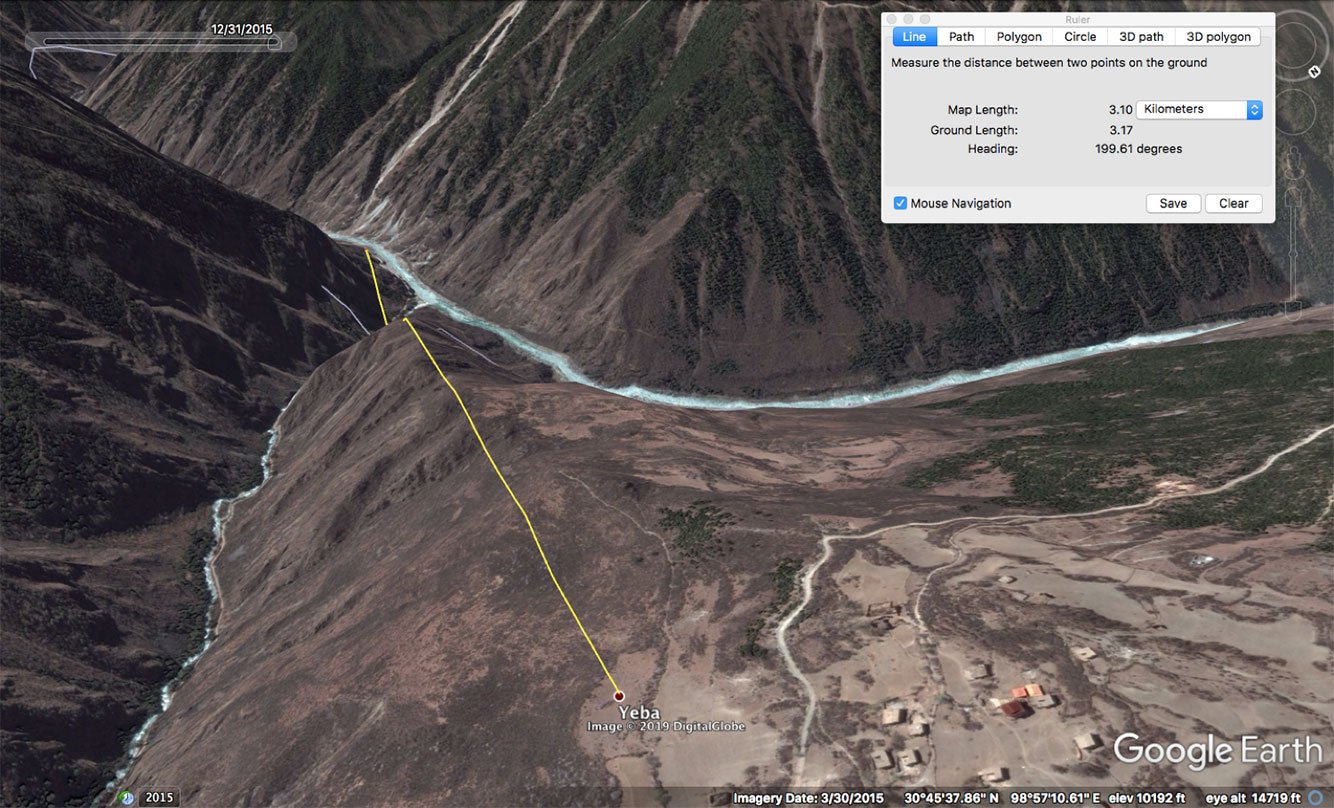
These two Google Earth images of the area are dated March 30, 2015; more recent images would reveal more advanced construction.

These two Google Earth images of the area are dated March 30, 2015; more recent images would reveal more advanced construction.
Lawa (拉哇) Hydropower Station is being built over the Drichu River, between Lhaba (Lawa) Township in Bathang (Batang) County in Kardze (Ganzi) TAP in Sichuan Province and Drupalung (Zhubalong) Township in Markham (Mangkang) County, Chamdo (Changdu), TAR. It is a major project prioritized in the 12th and now 13th Five-Year Plan, and construction was officially approved in January 2019 according to the Power China company.
The report states that construction work had been held up due to two landslides at the end of 2018. This Chinese social media posting documenting the work on the project states that drilling on the right bank of the river began in November 2011 and concluded in June 2014.
Lawa (拉哇) Hydropower Station is being built over the Drichu River, between Lhaba (Lawa) Township in Bathang (Batang) County in Kardze (Ganzi) TAP in Sichuan Province and Drupalung (Zhubalong) Township in Markham (Mangkang) County, Chamdo (Changdu), TAR. It is a major project prioritized in the 12th and now 13th Five-Year Plan, and construction was officially approved in January 2019 according to the Power China company.
The report states that construction work had been held up due to two landslides at the end of 2018. This Chinese social media posting documenting the work on the project states that drilling on the right bank of the river began in November 2011 and concluded in June 2014.

This graphic of the Lawa hydropower station is from the official Power China website.

This graphic of the Lawa hydropower station is from the official Power China website.

This satellite image shows the location of the Lawa hydropower station, dated February 2016.

This satellite image shows the location of the Lawa hydropower station, dated February 2016.
Bathang (巴塘) Hydropower Station is located nine kilometers west of Bathang (Batang) County town towards the Drichu River and neighboring Markham (Mangkang) County in the TAR. Announcing its approval in October 2017, a notice by the Sichuan People’s Government referred to its importance in ensuring “long-term stability”—a political term referring to the Chinese Communist Party’s imperative of ensuring compliance with party policy and crushing all opposition and even mild criticism. The official report states: “Batang Hydropower Station is the third hydropower station approved by the upper reaches of the Jinsha River and is a key project of the National Development and Reform Commission’s 13th Five-Year Plan for Renewable Energy Development. The power station approved the construction of the development and utilization of hydropower resources in the upper reaches of the Jinsha River, the establishment of a national high-quality clean energy base, the implementation of the ‘West-to-East Power Transmission’ strategy, and the creation of a clean energy demonstration province are of great significance, and promote the economic and social development of Tibetan areas and long-term stability.” (Posting on Oct. 30, 2017.)
According to the Assets Supervision and Administration Commission of the State Council, the hydropower station is scheduled to dam the river in 2020, putting the first unit into operation by the end of 2022.
Bathang (巴塘) Hydropower Station is located nine kilometers west of Bathang (Batang) County town towards the Drichu River and neighboring Markham (Mangkang) County in the TAR. Announcing its approval in October 2017, a notice by the Sichuan People’s Government referred to its importance in ensuring “long-term stability”—a political term referring to the Chinese Communist Party’s imperative of ensuring compliance with party policy and crushing all opposition and even mild criticism. The official report states: “Batang Hydropower Station is the third hydropower station approved by the upper reaches of the Jinsha River and is a key project of the National Development and Reform Commission’s 13th Five-Year Plan for Renewable Energy Development. The power station approved the construction of the development and utilization of hydropower resources in the upper reaches of the Jinsha River, the establishment of a national high-quality clean energy base, the implementation of the ‘West-to-East Power Transmission’ strategy, and the creation of a clean energy demonstration province are of great significance, and promote the economic and social development of Tibetan areas and long-term stability.” (Posting on Oct. 30, 2017.)
According to the Assets Supervision and Administration Commission of the State Council, the hydropower station is scheduled to dam the river in 2020, putting the first unit into operation by the end of 2022.

This Google Earth image, dated 2016, shows the location of the Batang hydropower station.

This Google Earth image, dated 2016, shows the location of the Batang hydropower station.
Tringpo (Changbo) Hydropower Station is located 4.5 kilometers from Tringpo township at the border between Gartok/Markham (Mangkang) in Chamdo (Changdu), TAR and Bathang (Batang) County, Kardze (Ganzi), Sichuan Province. The ‘Network of Yangtze River Water Resources’ published news of an environmental impact assessment at the site in 2017: http://www.cjw.gov.cn/xwzx/njcsm/jgsydt/29072.html
Tringpo (Changbo) Hydropower Station is located 4.5 kilometers from Tringpo township at the border between Gartok/Markham (Mangkang) in Chamdo (Changdu), TAR and Bathang (Batang) County, Kardze (Ganzi), Sichuan Province. The ‘Network of Yangtze River Water Resources’ published news of an environmental impact assessment at the site in 2017: http://www.cjw.gov.cn/xwzx/njcsm/jgsydt/29072.html

This Google Earth image of the site is dated 2015.

This Google Earth image of the site is dated 2015.
Polo (Boluo) Hydropower Station on the Drichu River is at the boundary of Jomda (Jiangda) County, Chamdo (Changdu), TAR, and Palyul (Baiyu) County, Kardze TAP, Sichuan Province. In 2016, Chinese state media announced that it had “successfully connected the county to the power grid.” (April 21, 2016, ‘Electricity officially generated at Tibet’s Boluo hydropower station’.
In November 2018, Polo Township was hit by a huge landslide. The image below shows the flooding that resulted.

Flooding following a landslide at the Polo hydropower site in November 2018; image from Chinese state media.

Flooding following a landslide at the Polo hydropower site in November 2018; image from Chinese state media.

Rescue operation following a landslide at the Polo hydropower site in November 2018; image from Chinese state media at http://tibet.news.cn/ywjj/2018-11/10/c_137596539.htm

Rescue operation following a landslide at the Polo hydropower site in November 2018; image from Chinese state media at http://tibet.news.cn/ywjj/2018-11/10/c_137596539.htm

This 2015 image from Chinese state media shows workers marking the start of construction of the Polo Hydropower Station.

This 2015 image from Chinese state media shows workers marking the start of construction of the Polo Hydropower Station.

Location of Polo power station shown on Google Earth in 2016.

Location of Polo power station shown on Google Earth in 2016.
Kamtok (Gangtuo) Hydropower Station located over the Drichu River in Kamtok Township, Jomda (Jiangda) County, Chamdo (Changdu) City, TAR. (Some Chinese sources state that the township is in Kardze, Sichuan, which is incorrect). The 2016 feasibility study of the project is at this official source.
In November 2011, the NDRC and the relevant state ministries and commissions and the Sichuan, TAR, Handan, and Qinghai governments reviewed the hydropower planning report of the upper reaches of the Drichu River and agreed to use Kamtok as the leading reservoir. According to state news agency Xinhua, this hydropower program had “a total installed capacity of over 10 million kilowatts. Among them, the No. 8 power stations in the Sichuan-Tibet section are Gangtuo, Yanbi, Boluo, Yebatan, Lawa, Batang, Suyulong and Changbo Power Stations, all of which are powered by Huadian Jinsha River upstream of Huadian Group.” (Xinhua, August 28, 2017).
Kamtok (Gangtuo) Hydropower Station located over the Drichu River in Kamtok Township, Jomda (Jiangda) County, Chamdo (Changdu) City, TAR. (Some Chinese sources state that the township is in Kardze, Sichuan, which is incorrect). The 2016 feasibility study of the project is at this official source.
In November 2011, the NDRC and the relevant state ministries and commissions and the Sichuan, TAR, Handan, and Qinghai governments reviewed the hydropower planning report of the upper reaches of the Drichu River and agreed to use Kamtok as the leading reservoir. According to state news agency Xinhua, this hydropower program had “a total installed capacity of over 10 million kilowatts. Among them, the No. 8 power stations in the Sichuan-Tibet section are Gangtuo, Yanbi, Boluo, Yebatan, Lawa, Batang, Suyulong and Changbo Power Stations, all of which are powered by Huadian Jinsha River upstream of Huadian Group.” (Xinhua, August 28, 2017).

Site of Gangtuo hydropower project in 2014, Google Earth.

Site of Gangtuo hydropower project in 2014, Google Earth.
Xulong (旭龙) Hydropower Station is being built over the Drichu River in Yangla Township, Dechen (Diqing) County, Dechen TAP in Yunnan Province, close to the border with Kardze TAP. The NDRC approved the “Jinsha River Upstream Hydropower Planning Report” in 2012, agreeing to the “’One reservoir and thirteen’ cascade layout and resource planning plan for the upper reaches of the Jinsha River,” according to an official posting on June 12, 2017 by the Changjiang Institute of Survey, Planning, Design and Engineering. It said that Xulong “should accelerate the preliminary work of the spirit and requirements” of meetings about the hydropower project. Survey and design work began in 2004.
According to a more recent state media report, the project will involve resettlement and relocation. In a state media report on Nov. 28, 2018, “Relevant resettlement planning and other urgent matters will strengthen cooperation and promote the early approval of the project.”
Xulong (旭龙) Hydropower Station is being built over the Drichu River in Yangla Township, Dechen (Diqing) County, Dechen TAP in Yunnan Province, close to the border with Kardze TAP. The NDRC approved the “Jinsha River Upstream Hydropower Planning Report” in 2012, agreeing to the “’One reservoir and thirteen’ cascade layout and resource planning plan for the upper reaches of the Jinsha River,” according to an official posting on June 12, 2017 by the Changjiang Institute of Survey, Planning, Design and Engineering. It said that Xulong “should accelerate the preliminary work of the spirit and requirements” of meetings about the hydropower project. Survey and design work began in 2004.
According to a more recent state media report, the project will involve resettlement and relocation. In a state media report on Nov. 28, 2018, “Relevant resettlement planning and other urgent matters will strengthen cooperation and promote the early approval of the project.”

Image of the site of Xu Long hydropower station from official Chinese media, http://www.cjwsjy.com.cn/kcsj/11816.jhtml

Image of the site of Xu Long hydropower station from official Chinese media, http://www.cjwsjy.com.cn/kcsj/11816.jhtml

Google Earth image of the Xu Long site dated 2011.

Google Earth image of the Xu Long site dated 2011.
Kongtsi Rawa (Benzilan, 奔子栏) Hydropower Station is located at Kongtsi Rawa Township, Dechen County, Dechen (Diqing) TAP in Yunnan Province. According to China Society For Hydropower Engineering, the hydropower projects of Kongtsi Rawa and Xulong (above) were signed with the China Guodian Corporation for more than 51.5 billion yuan (March 15, 2017, http://www.hydropower.org.cn/showNewsDetail.asp?nsId=20771). Hao Peng, secretary of the Party Committee of the State-owned Assets Supervision and Administration Commission, was quoted saying the projects were important elements of Sichuan’s involvement in the “Belt and Road” Initiative (BRI).
On May 14-16, 2016, the China Power website featured a visit to the Kongtsi Rawa and Xulong hydropower sites by Liu Qi, deputy director of the National Energy Administration, in order to assess progress. He emphasized that the projects were part of the National Energy Development Plan. The official line was repeated: “The project construction will promote the social economic development of the Tibetan areas and play an important role in poverty alleviation and improvement of the people’s production and living condition in these Tibetan areas.” (May 24, 2016.)
Kongtsi Rawa (Benzilan, 奔子栏) Hydropower Station is located at Kongtsi Rawa Township, Dechen County, Dechen (Diqing) TAP in Yunnan Province. According to China Society For Hydropower Engineering, the hydropower projects of Kongtsi Rawa and Xulong (above) were signed with the China Guodian Corporation for more than 51.5 billion yuan (March 15, 2017, http://www.hydropower.org.cn/showNewsDetail.asp?nsId=20771). Hao Peng, secretary of the Party Committee of the State-owned Assets Supervision and Administration Commission, was quoted saying the projects were important elements of Sichuan’s involvement in the “Belt and Road” Initiative (BRI).
On May 14-16, 2016, the China Power website featured a visit to the Kongtsi Rawa and Xulong hydropower sites by Liu Qi, deputy director of the National Energy Administration, in order to assess progress. He emphasized that the projects were part of the National Energy Development Plan. The official line was repeated: “The project construction will promote the social economic development of the Tibetan areas and play an important role in poverty alleviation and improvement of the people’s production and living condition in these Tibetan areas.” (May 24, 2016.)

Google Earth image of location of Kongtsi Rawa hydropower station in 2014.

Google Earth image of location of Kongtsi Rawa hydropower station in 2014.
Longpan (龙盘) Hydropower Station is being built over the Drichu river at the boundary of Gyalthang County (Xianggelila), Dechen (Deqing) TAP and Yulong County of Lijiang City, Yunnan Province. The area is formally referred to as Hutiaoxia, meaning Tiger Leaping Gorge, one of the deepest narrow valleys in China. The project has been prioritized for several years. For instance, see this 2014 article by the China Society For Hydropower Engineering on May 21, 2014: http://www.hydropower.org.cn/showNewsDetail.asp?nsId=13074. The article quotes An Shenyi, former vice president and chief engineer of planning of Central South Survey and Design Research Institute, telling reporters that with the acceleration of Yunnan’s Water Diversion Project, considering the factors of good water sources, low investment and optimal comprehensive benefits, we should strive for the construction of Long-Pan Hydropower Station as soon as possible.” An Shenyi said in the same article that the 17 cascade hydropower stations planned by the Yangtze River from the Tiger Leaping Gorge have an installed capacity of about 90 million kilowatts, of which the leading reservoir is Longpan Reservoir. Commentators have voiced alarm that Longpan will be constructed in an active seismic zone (for instance, this article from August, 2011: http://blog.sina.com.cn/s/blog_6c2bddb20100x1y4.html). ICT’s report gives further details on Longpan.
Longpan (龙盘) Hydropower Station is being built over the Drichu river at the boundary of Gyalthang County (Xianggelila), Dechen (Deqing) TAP and Yulong County of Lijiang City, Yunnan Province. The area is formally referred to as Hutiaoxia, meaning Tiger Leaping Gorge, one of the deepest narrow valleys in China. The project has been prioritized for several years. For instance, see this 2014 article by the China Society For Hydropower Engineering on May 21, 2014: http://www.hydropower.org.cn/showNewsDetail.asp?nsId=13074. The article quotes An Shenyi, former vice president and chief engineer of planning of Central South Survey and Design Research Institute, telling reporters that with the acceleration of Yunnan’s Water Diversion Project, considering the factors of good water sources, low investment and optimal comprehensive benefits, we should strive for the construction of Long-Pan Hydropower Station as soon as possible.” An Shenyi said in the same article that the 17 cascade hydropower stations planned by the Yangtze River from the Tiger Leaping Gorge have an installed capacity of about 90 million kilowatts, of which the leading reservoir is Longpan Reservoir. Commentators have voiced alarm that Longpan will be constructed in an active seismic zone (for instance, this article from August, 2011: http://blog.sina.com.cn/s/blog_6c2bddb20100x1y4.html). ICT’s report gives further details on Longpan.

Google Earth images of the Longpan site location from 2016.

Google Earth images of the Longpan site location from 2016.
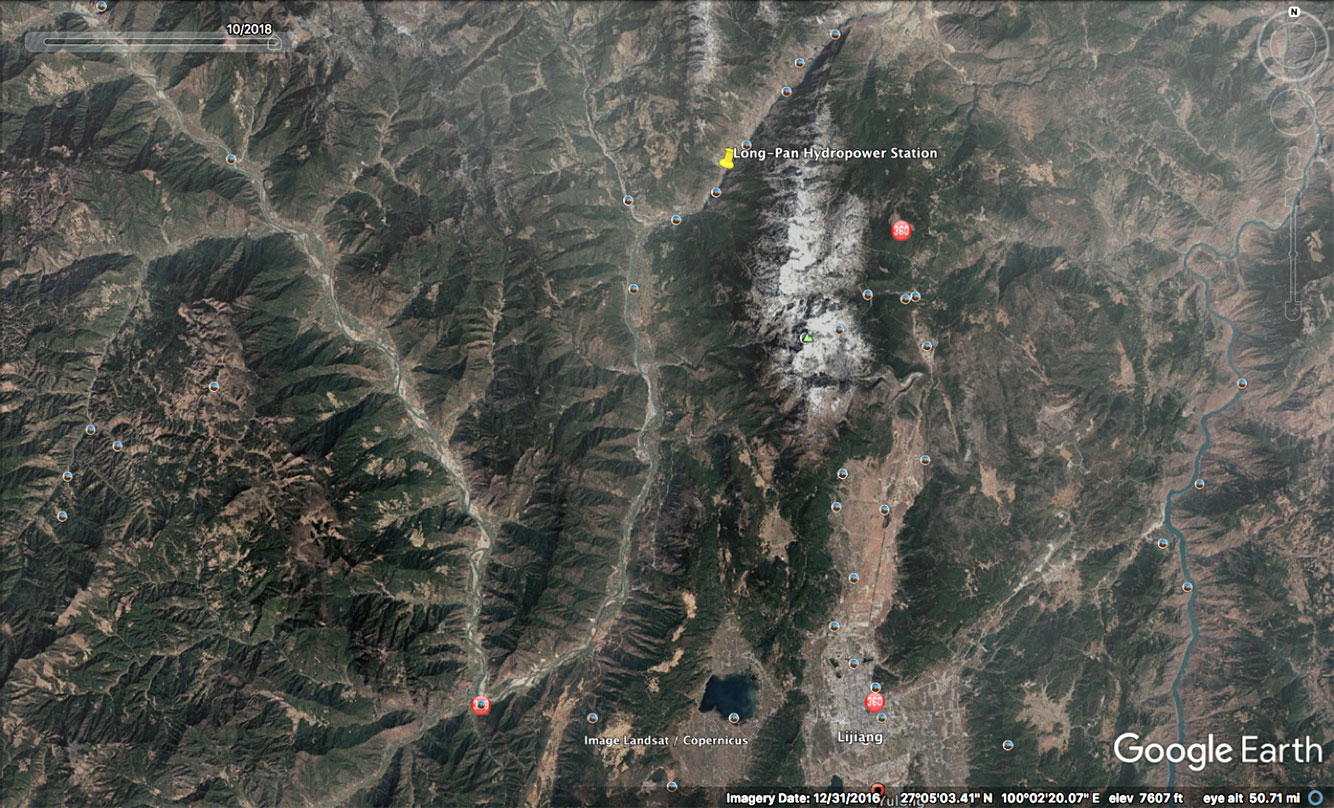
Google Earth images of the Longpan site location from 2016.

Google Earth images of the Longpan site location from 2016.
LIST OF NEW HYDROPOWER STATION PROJECTS OVER YARLUNG TSANGPO RIVER PROPOSED BY THE 13TH FIVE YEAR PLAN
LIST OF NEW HYDROPOWER STATION PROJECTS OVER YARLUNG TSANGPO RIVER PROPOSED BY THE 13TH FIVE YEAR PLAN
Yagen Hydropower Stations (牙根一级水电站) is in Nyagchu County (Yajiang), Kardze TAP, Sichuan Province. These two hydropower plants are being built over the longest river of the TAR, the Yarlung Tsangpo, the upper stream of the Brahmaputra before it flows into Arunachal Pradesh, India. Kardze Daily reported on July 7, 2015: “Ya Gen Hydropower Station (Class B) is the third plant of the seventh cascade Hydropower development in the middle reaches of Yarlung Tsangpo River.” (http://paper.kbcmw.com/html/2015-07/07/content_73579.htm) The same article states the extent of resettlement, reporting that: “1,796 people will be resettled, two towns and one religious activity site will be relocated, and there will be no centralized resettlement sites.” No further details are known at present about the extent of the relocation, but an earlier official source stated that the project was due to be completed by 2017. (https://baike.so.com/doc/5045213-5272097.html)
Yagen Hydropower Stations (牙根一级水电站) is in Nyagchu County (Yajiang), Kardze TAP, Sichuan Province. These two hydropower plants are being built over the longest river of the TAR, the Yarlung Tsangpo, the upper stream of the Brahmaputra before it flows into Arunachal Pradesh, India. Kardze Daily reported on July 7, 2015: “Ya Gen Hydropower Station (Class B) is the third plant of the seventh cascade Hydropower development in the middle reaches of Yarlung Tsangpo River.” (http://paper.kbcmw.com/html/2015-07/07/content_73579.htm) The same article states the extent of resettlement, reporting that: “1,796 people will be resettled, two towns and one religious activity site will be relocated, and there will be no centralized resettlement sites.” No further details are known at present about the extent of the relocation, but an earlier official source stated that the project was due to be completed by 2017. (https://baike.so.com/doc/5045213-5272097.html)




GOOGLE EARTH IMAGES FROM 2011 SHOWING THE LOCATIONS OF THE HYDROPOWER STATIONS
GOOGLE EARTH IMAGES FROM 2011 SHOWING THE LOCATIONS OF THE HYDROPOWER STATIONS
Mengdigou (孟底沟水电站, Xiaomendigou) Hydropower Station is at the boundary of Gyazur (Jiulong) County, Kardze TAP and Muli Tibetan Autonomous County in Sichuan Province. The site of the dam is around half a kilometer from the Mengdigou valley and Shangtuan Township at the lower reaches of the Yarlung Tsangpo. An announcement by the Sichuan People’s Government of the dam in 2010 makes it very clear that no opposition is possible, and that local people have no choice but to comply with the government’s orders. Announcing the construction of the hydropower station, the announcement says that: “From June 21, 2010, new construction projects and immigrant populations are prohibited in the reservoir inundation area and hub construction area of Xiaomendigou Hydropower Station. (Sichuan Provincial government, June 17, 2010)
A report in Chinese state media from 2012 gives further details on the project: http://www.sc.gov.cn/10462/10464/10727/10742/2012/8/28/10223906.shtml
Mengdigou (孟底沟水电站, Xiaomendigou) Hydropower Station is at the boundary of Gyazur (Jiulong) County, Kardze TAP and Muli Tibetan Autonomous County in Sichuan Province. The site of the dam is around half a kilometer from the Mengdigou valley and Shangtuan Township at the lower reaches of the Yarlung Tsangpo. An announcement by the Sichuan People’s Government of the dam in 2010 makes it very clear that no opposition is possible, and that local people have no choice but to comply with the government’s orders. Announcing the construction of the hydropower station, the announcement says that: “From June 21, 2010, new construction projects and immigrant populations are prohibited in the reservoir inundation area and hub construction area of Xiaomendigou Hydropower Station. (Sichuan Provincial government, June 17, 2010)
A report in Chinese state media from 2012 gives further details on the project: http://www.sc.gov.cn/10462/10464/10727/10742/2012/8/28/10223906.shtml


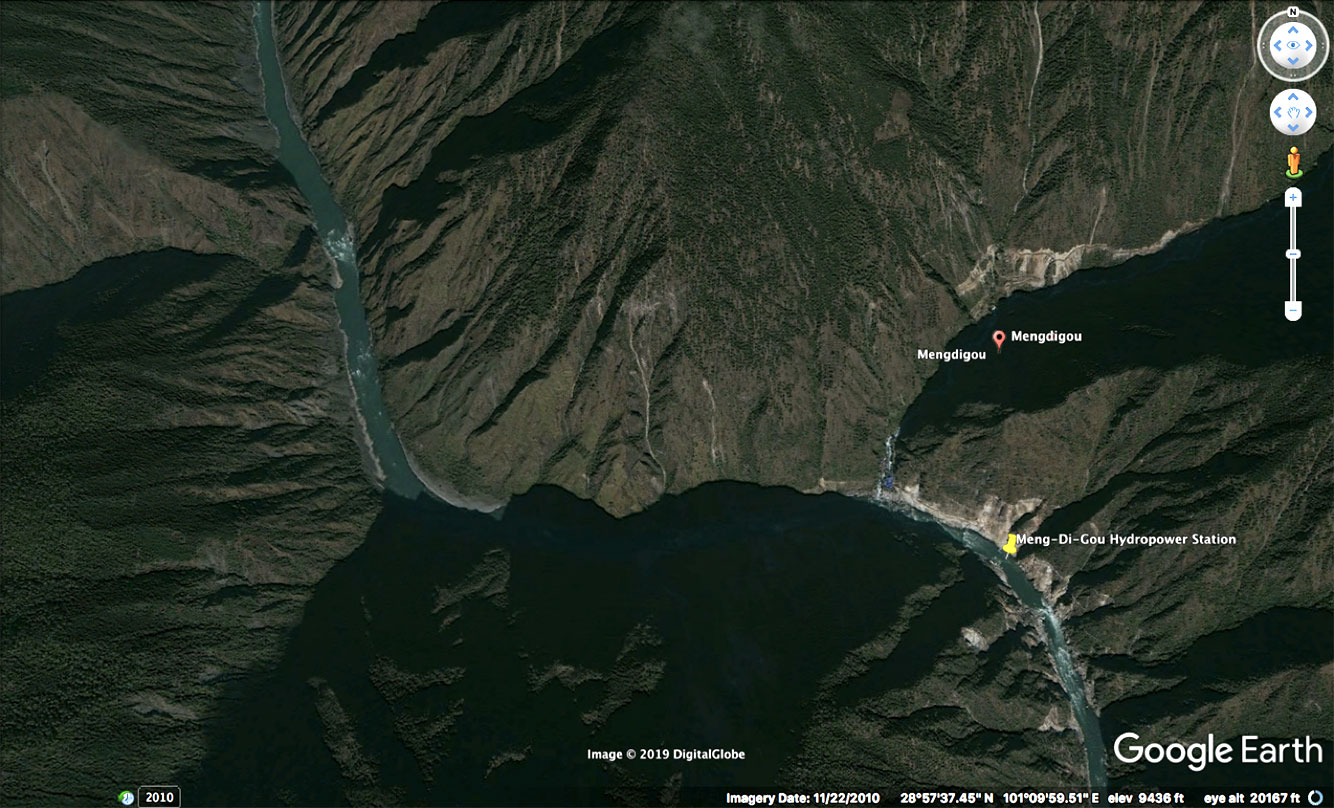

LOCATION OF THE MENG DI GUO HYDROPOWER STATION IN 2010
LOCATION OF THE MENG DI GUO HYDROPOWER STATION IN 2010
Kalha Hydropower Station (卡拉水电站) is in Kalha (Chinese: Kala) Township, Muli Tibetan Autonomous County, Sichuan Province.
Ganzi Daily reported on Aug. 27, 2013, that “The installed capacity of the Yagen II and Kara Hydropower Station is initially set at 990,000 kilowatts and 1 million kilowatts” and that it “is under construction and management by the Yalong River Basin Hydropower Development Co., Ltd.” (http://gz.newssc.org/system/20130827/001177631.html)
Kalha Hydropower Station (卡拉水电站) is in Kalha (Chinese: Kala) Township, Muli Tibetan Autonomous County, Sichuan Province.
Ganzi Daily reported on Aug. 27, 2013, that “The installed capacity of the Yagen II and Kara Hydropower Station is initially set at 990,000 kilowatts and 1 million kilowatts” and that it “is under construction and management by the Yalong River Basin Hydropower Development Co., Ltd.” (http://gz.newssc.org/system/20130827/001177631.html)

3D image of the completed dam at Khala, Muli, as depicted by the Large Dam Safety Supervision Center, National Energy Administration at: http://www.dam.com.cn/damView/view.jsp?id=1694

3D image of the completed dam at Khala, Muli, as depicted by the Large Dam Safety Supervision Center, National Energy Administration at: http://www.dam.com.cn/damView/view.jsp?id=1694

The location of the hydropower station of Kala captured in 2013.

The location of the hydropower station of Kala captured in 2013.

The location of the hydropower station of Kala captured in 2013.

The location of the hydropower station of Kala captured in 2013.
Lenggu Hydropower Station (楞古水电站) is being built on the border of Nyagchu County (Yajiang) and Dartsedo (Kangding) County, Kardze TAP, Sichuan Province. Official confirmation of resettlement associated with the project was confirmed by the China Society for Hydropower Engineering, which reported that with regard to this hydropower project, “The National Development and Reform Commission (NDRC) requested that it attach great importance to the ecological environmental protection and resettlement work of the project construction, which will help the immigrants get rid of poverty and promote ecological environment construction as an important goal of hydropower development, and formulate practical ecological protection and resettlement measures. The construction of power stations must implement the new policy of hydropower development after ‘first immigration and construction.’” (Aug. 18, 2014, http://www.hydropower.org.cn/showNewsDetail.asp?nsId=14011).
A Nyagchu County government posting gives more detail on numbers of those relocated, stating on Nov. 10, 2015 that the government was working on relocations associated only with preliminary construction work, indicating that more might follow: “Implementing the relocation of 910 people from 181 households in four villages in Drugan Chukha Township to meet the preliminary construction work for Ya Gen Hydropower Station (class A) and Leng Gu Hydropower Station.” (http://www.yajiang.gov.cn/13372/13374/13423/2015/11/10/10503636.shtml)
Lenggu Hydropower Station (楞古水电站) is being built on the border of Nyagchu County (Yajiang) and Dartsedo (Kangding) County, Kardze TAP, Sichuan Province. Official confirmation of resettlement associated with the project was confirmed by the China Society for Hydropower Engineering, which reported that with regard to this hydropower project, “The National Development and Reform Commission (NDRC) requested that it attach great importance to the ecological environmental protection and resettlement work of the project construction, which will help the immigrants get rid of poverty and promote ecological environment construction as an important goal of hydropower development, and formulate practical ecological protection and resettlement measures. The construction of power stations must implement the new policy of hydropower development after ‘first immigration and construction.’” (Aug. 18, 2014, http://www.hydropower.org.cn/showNewsDetail.asp?nsId=14011).
A Nyagchu County government posting gives more detail on numbers of those relocated, stating on Nov. 10, 2015 that the government was working on relocations associated only with preliminary construction work, indicating that more might follow: “Implementing the relocation of 910 people from 181 households in four villages in Drugan Chukha Township to meet the preliminary construction work for Ya Gen Hydropower Station (class A) and Leng Gu Hydropower Station.” (http://www.yajiang.gov.cn/13372/13374/13423/2015/11/10/10503636.shtml)

Images from 2015 of the location of Leng Gu hydropower station.

Images from 2015 of the location of Leng Gu hydropower station.
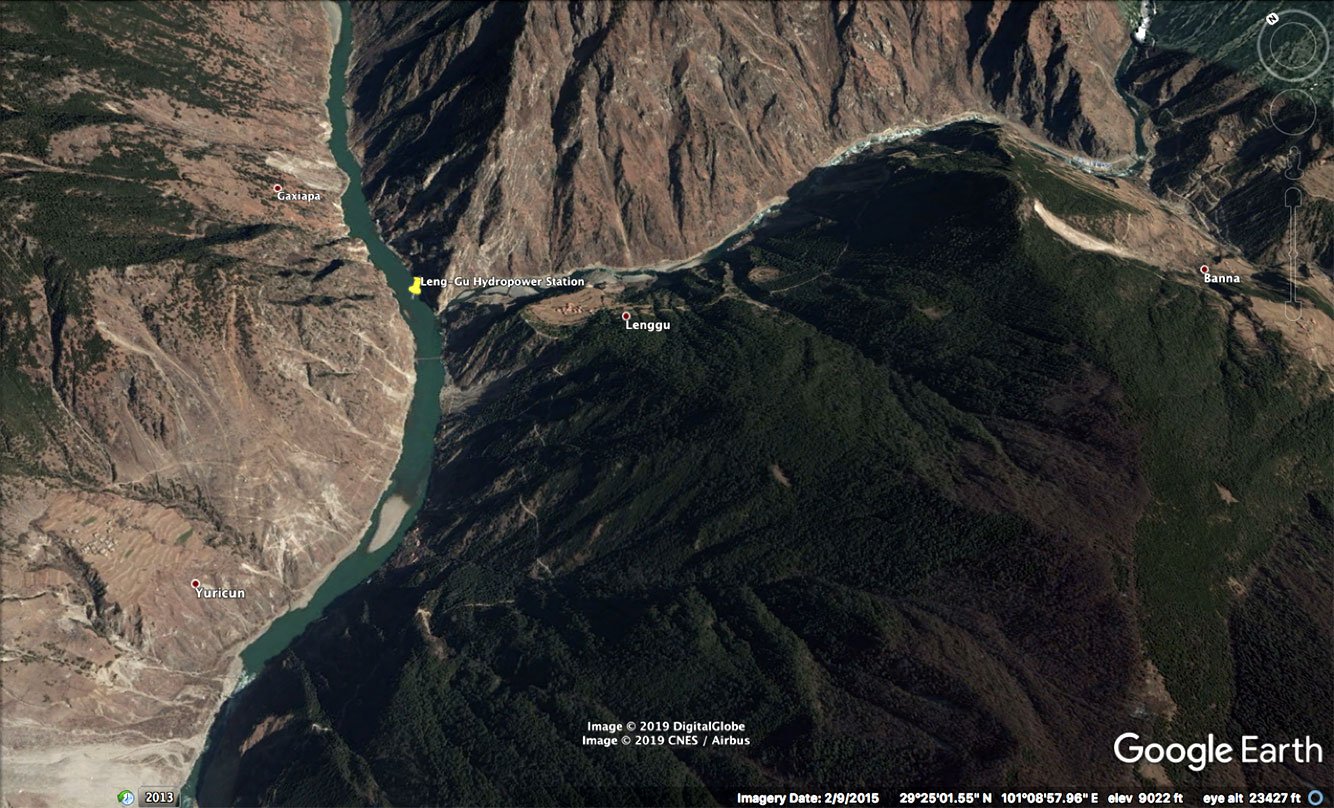
Images from 2015 of the location of Leng Gu hydropower station.

Images from 2015 of the location of Leng Gu hydropower station.
LIST OF NEW HYDROPOWER STATION PROJECTS OVER GYALMO NGULCHU OR SALWEEN RIVER (CHINESE: NU) IN THE DADU RIVER BASIN PROPOSED IN THE 13TH FIVE YEAR PLAN
LIST OF NEW HYDROPOWER STATION PROJECTS OVER GYALMO NGULCHU OR SALWEEN RIVER (CHINESE: NU) IN THE DADU RIVER BASIN PROPOSED IN THE 13TH FIVE YEAR PLAN
Jinchuan (金川水电站) Hydropower Station is being built on the Gyalmo Ngulchu River, which flows from the Tibetan plateau into southeast Asia. It is in Chunchen County (Jinchuan), Ngaba (Aba) Tibetan and Qiang Autonomous Prefecture, Sichuan Province. According to an announcement made April 16, 2019, the power station was a priority for the province in the first quarter of 2019 and is expected to be completed and put into operation in 2025. (Aba Development and Reform Commission, http://www.abazhou.gov.cn/jrab/zwyw/201904/t20190416_1390877.html) The same posting states: “Jinchuan Hydropower Station is the sixth cascade Hydropower Station chain in Ngaba on the Dadu River, and is one of the important hydropower stations. The total investment of the power plant is estimated about 12.22 billion yuan.”
In a further posting the Jinchuan County government said: “Jinchuan Hydropower Station […] is the sixth-level power station in the 28-level plan for the Dadu River mainstream hydropower planning. It is the upstream Shuangjiangkou power station counter-regulation reservoir. The power station is mainly based on power generation. It uses 4 sets of 215,000 kilowatts of mixed-flow turbine generator sets with a total installed capacity of 860,000 kilowatts. When combined with the Shuangjiangkou power station, the average annual power generation is about 3.485 billion kilowatt-hours. The reservoir has a normal water storage capacity of 2,253 meters and a total storage capacity of 508.5 million cubic meters. It has daily adjustment capacity and a total investment of about 12.1 billion yuan. It is developed and constructed by Guodian Dadu River Basin Hydropower Development Co., Ltd. The power station is expected to be completed and put into operation in 2024, and the power generation is expected to be fully absorbed in Sichuan Province.” (Feb. 18, 2019: http://www.abjinchuan.gov.cn/zwgk_34038/zwdt/201902/t20190218_1385198.html)
Jinchuan (金川水电站) Hydropower Station is being built on the Gyalmo Ngulchu River, which flows from the Tibetan plateau into southeast Asia. It is in Chunchen County (Jinchuan), Ngaba (Aba) Tibetan and Qiang Autonomous Prefecture, Sichuan Province. According to an announcement made April 16, 2019, the power station was a priority for the province in the first quarter of 2019 and is expected to be completed and put into operation in 2025. (Aba Development and Reform Commission, http://www.abazhou.gov.cn/jrab/zwyw/201904/t20190416_1390877.html) The same posting states: “Jinchuan Hydropower Station is the sixth cascade Hydropower Station chain in Ngaba on the Dadu River, and is one of the important hydropower stations. The total investment of the power plant is estimated about 12.22 billion yuan.”
In a further posting the Jinchuan County government said: “Jinchuan Hydropower Station […] is the sixth-level power station in the 28-level plan for the Dadu River mainstream hydropower planning. It is the upstream Shuangjiangkou power station counter-regulation reservoir. The power station is mainly based on power generation. It uses 4 sets of 215,000 kilowatts of mixed-flow turbine generator sets with a total installed capacity of 860,000 kilowatts. When combined with the Shuangjiangkou power station, the average annual power generation is about 3.485 billion kilowatt-hours. The reservoir has a normal water storage capacity of 2,253 meters and a total storage capacity of 508.5 million cubic meters. It has daily adjustment capacity and a total investment of about 12.1 billion yuan. It is developed and constructed by Guodian Dadu River Basin Hydropower Development Co., Ltd. The power station is expected to be completed and put into operation in 2024, and the power generation is expected to be fully absorbed in Sichuan Province.” (Feb. 18, 2019: http://www.abjinchuan.gov.cn/zwgk_34038/zwdt/201902/t20190218_1385198.html)

Google Earth image of the location of the hydropower station at Jinchuan.

Google Earth image of the location of the hydropower station at Jinchuan.

Google Earth image of the location of the hydropower station at Jinchuan.

Google Earth image of the location of the hydropower station at Jinchuan.
Badi Hydropower Station (巴底水电站) is in Badi Township, Chunchen County (Jinchuan), Ngaba (Aba) T&QAP, Sichuan Province. Preliminary work was approved in 2013, according to the People’s Government of Sichuan province, Jan. 15, 2013: http://www.sc.gov.cn/10462/10464/10465/10574/2013/1/15/10244540.shtml
A further official source covered a visit from the Beijing Engineering Corporation Limited Company to the site in 2014: http://www.bhidi.com/detail.asp?id=102. According to an official source in Chuchen County on Sept. 19, 2017, “Badi hydropower project’s pre-site survey and design work has basically been completed, the feasibility study report has been completed and consulted, and the next major task is to carry out the work of migration and relocation project in the area of the hydropower station.” (http://www.abjinchuan.gov.cn/zwgk_34038/zdlyxxgk/zdxmjs/201709/t20170919_1276895.html).
Badi Hydropower Station (巴底水电站) is in Badi Township, Chunchen County (Jinchuan), Ngaba (Aba) T&QAP, Sichuan Province. Preliminary work was approved in 2013, according to the People’s Government of Sichuan province, Jan. 15, 2013: http://www.sc.gov.cn/10462/10464/10465/10574/2013/1/15/10244540.shtml
A further official source covered a visit from the Beijing Engineering Corporation Limited Company to the site in 2014: http://www.bhidi.com/detail.asp?id=102. According to an official source in Chuchen County on Sept. 19, 2017, “Badi hydropower project’s pre-site survey and design work has basically been completed, the feasibility study report has been completed and consulted, and the next major task is to carry out the work of migration and relocation project in the area of the hydropower station.” (http://www.abjinchuan.gov.cn/zwgk_34038/zdlyxxgk/zdxmjs/201709/t20170919_1276895.html).

Location of Badi hydropower station shown on Google Earth.

Location of Badi hydropower station shown on Google Earth.
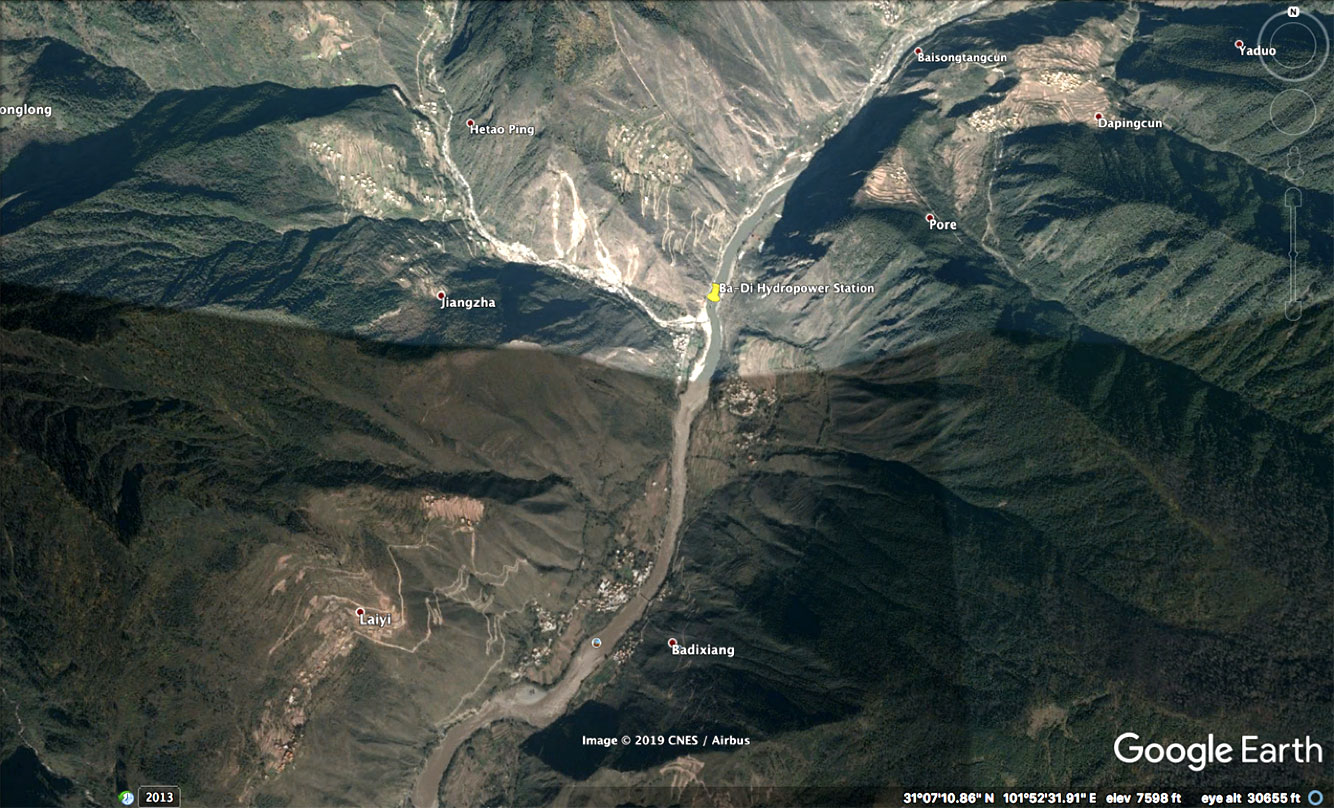
Location of Badi hydropower station shown on Google Earth.

Location of Badi hydropower station shown on Google Earth.
Yingliang (Liangbao) Hydropower Station (硬梁水电站) is in Lunan (Lengqi) Township, Chagsam County (Luding), Kardze TAP, Sichuan Province. Plans for resettlement due to dam construction were outlined in 2016, according to state media reports. The government of Chagsam County outlined the priorities in a “mobilization meeting” about resettlement, saying the thoughts of the people should be “unified” according to the imperatives of “environmental protection, resettlement, and social stability.” (March 22, 2016, http://www.luding.gov.cn/11503/11507/11547/11618/2016/03/22/10515444.shtml) The China Gezhouba Group No.2 Engineering Company signed an official contract for construction last May 2018 (http://www.cggc2.ceec.net.cn/art/2018/5/28/art_12111_1655690.html)
Yingliang (Liangbao) Hydropower Station (硬梁水电站) is in Lunan (Lengqi) Township, Chagsam County (Luding), Kardze TAP, Sichuan Province. Plans for resettlement due to dam construction were outlined in 2016, according to state media reports. The government of Chagsam County outlined the priorities in a “mobilization meeting” about resettlement, saying the thoughts of the people should be “unified” according to the imperatives of “environmental protection, resettlement, and social stability.” (March 22, 2016, http://www.luding.gov.cn/11503/11507/11547/11618/2016/03/22/10515444.shtml) The China Gezhouba Group No.2 Engineering Company signed an official contract for construction last May 2018 (http://www.cggc2.ceec.net.cn/art/2018/5/28/art_12111_1655690.html)

Local county official Zhu Bangwen presided over a meeting to enforce official policy on resettlement in connection with the Liangbao hydro power project in 2016. Photo from official website: http://www.luding.gov.cn/11503/11507/11547/11618/2016/03/22/10515444.shtml

Local county official Zhu Bangwen presided over a meeting to enforce official policy on resettlement in connection with the Liangbao hydro power project in 2016. Photo from official website: http://www.luding.gov.cn/11503/11507/11547/11618/2016/03/22/10515444.shtml

Ying Liangbao hydropower station location, Google Earth.

Ying Liangbao hydropower station location, Google Earth.

Ying Liangbao hydropower station location, Google Earth.

Ying Liangbao hydropower station location, Google Earth.
Anning Hydropower Station (安宁水电站) is in Anning Township, Chunchen County (Jinchuan), Ngaba (Aba) TAP, Sichuan Province. An academic paper found on Baidu gives technical details: http://xueshu.baidu.com/usercenter/paper/show?paperid=dfcc432a2d1385d4b83e5a428538f9a1&site=xueshu_se)
Anning Hydropower Station (安宁水电站) is in Anning Township, Chunchen County (Jinchuan), Ngaba (Aba) TAP, Sichuan Province. An academic paper found on Baidu gives technical details: http://xueshu.baidu.com/usercenter/paper/show?paperid=dfcc432a2d1385d4b83e5a428538f9a1&site=xueshu_se)

Google Earth image of the site in 2015.

Google Earth image of the site in 2015.

Google Earth image of the site in 2015.

Google Earth image of the site in 2015.
Danba Hydropower Station (丹巴水电站) is in Chenpo Township, Rongdrak (Danba) County, Kardze TAP, Sichuan Province. An account of the project online acknowledges that “environmental conditions” are not favorable for construction (http://www.kunyuwy.com/cn/casedetails/87/16.html).
This image, below, of the construction site showcases technology used on the official site of Jiangyin Zhenbo Machinery Company (http://jyzhenbo.com/product1-4.asp)
Danba Hydropower Station (丹巴水电站) is in Chenpo Township, Rongdrak (Danba) County, Kardze TAP, Sichuan Province. An account of the project online acknowledges that “environmental conditions” are not favorable for construction (http://www.kunyuwy.com/cn/casedetails/87/16.html).
This image, below, of the construction site showcases technology used on the official site of Jiangyin Zhenbo Machinery Company (http://jyzhenbo.com/product1-4.asp)



Google Earth image of the site in 2015.

Google Earth image of the site in 2015.
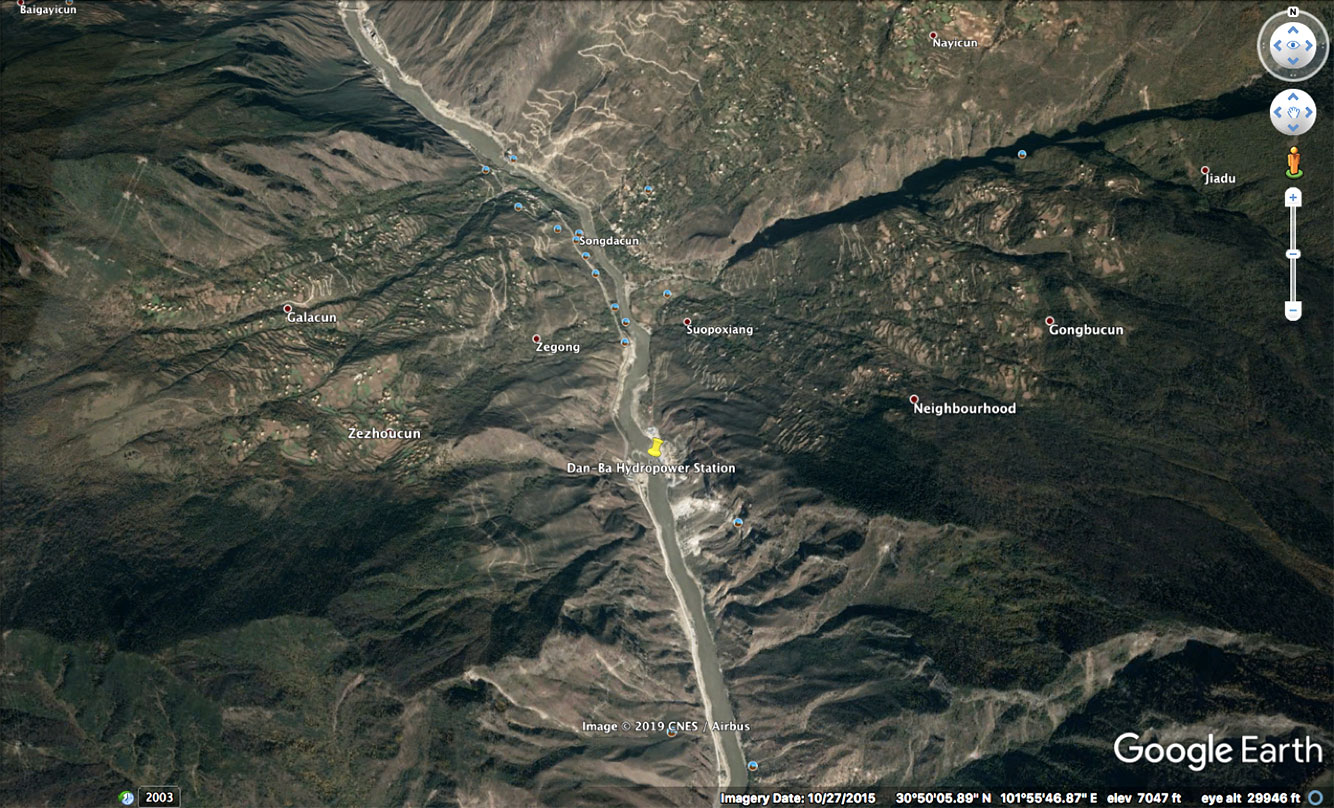
Google Earth image of the site in 2015.

Google Earth image of the site in 2015.
Ma’erdang Hydropower Station (玛尔挡水电站) is on the Machu River (Huang He) at the boundary of Ba Dzong (Tongde) County, Tsolho (Hainan) TAP and Machen (Maqin) County, Golok (Guoluo) TAP, Qinghai Province. Images posted on social media in 2017 depict advanced construction work at the site, and transportation routes from Xining and other hydropower stations on the Yellow River.
The image below shows Qinghai Party leaders visiting the site in January 2019:
Ma’erdang Hydropower Station (玛尔挡水电站) is on the Machu River (Huang He) at the boundary of Ba Dzong (Tongde) County, Tsolho (Hainan) TAP and Machen (Maqin) County, Golok (Guoluo) TAP, Qinghai Province. Images posted on social media in 2017 depict advanced construction work at the site, and transportation routes from Xining and other hydropower stations on the Yellow River.
The image below shows Qinghai Party leaders visiting the site in January 2019:



Google Earth image of the site dated 2015.

Google Earth image of the site dated 2015.
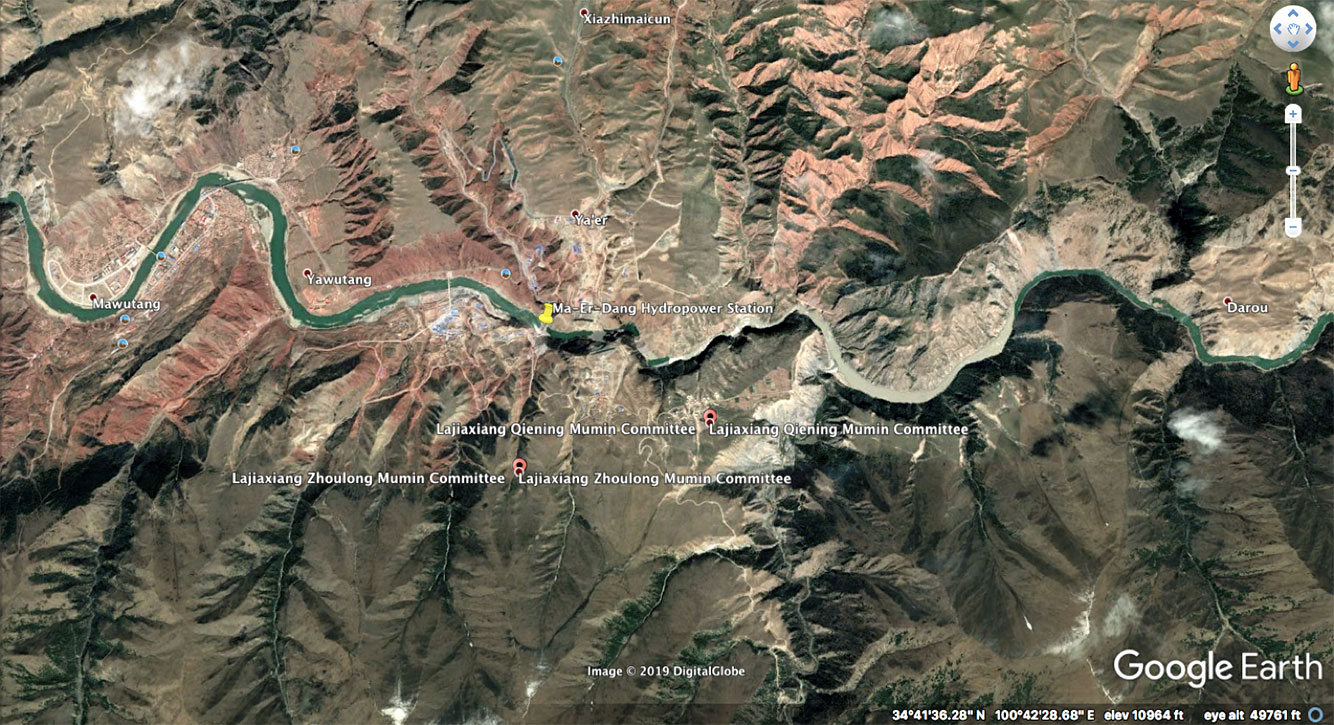
Google Earth image of the site dated 2015.

Google Earth image of the site dated 2015.
Yangqu Hydropower Station (羊曲水电站) is being built at Hokha Township, Dragkar (Xinghai) County, Tsolho TAP (Hainan) in Qinghai Province.
State media reports indicate a very high level of resettlement from damming on Tibetan rivers in Qinghai. According to a report in April 2019 in the official media: “By 2018, the central government has accumulatively approved 61,276 rural resettlement population indicators for large and medium-sized reservoirs in Qinghai Province. Qinghai Province has [relocated] 58,177 people, and has distributed a total of 399 million yuan of direct subsidies for immigrants.” (Haihe River Water Conservancy Commission, April 25, 2019, MWR)
This image from Baidu shows the construction site of the hydropower project:
Yangqu Hydropower Station (羊曲水电站) is being built at Hokha Township, Dragkar (Xinghai) County, Tsolho TAP (Hainan) in Qinghai Province.
State media reports indicate a very high level of resettlement from damming on Tibetan rivers in Qinghai. According to a report in April 2019 in the official media: “By 2018, the central government has accumulatively approved 61,276 rural resettlement population indicators for large and medium-sized reservoirs in Qinghai Province. Qinghai Province has [relocated] 58,177 people, and has distributed a total of 399 million yuan of direct subsidies for immigrants.” (Haihe River Water Conservancy Commission, April 25, 2019, MWR)
This image from Baidu shows the construction site of the hydropower project:

Google Earth image of the location of the project.

Google Earth image of the location of the project.

Google Earth image of the location of the project.

Google Earth image of the location of the project.
HYDROPOWER PROJECTS IN OTHER TIBETAN AREAS
HYDROPOWER PROJECTS IN OTHER TIBETAN AREAS
Cihaxia Hydropower Station (茨 哈峡水电站) is at the boundary of Dragkar (Xinghai) County and Ba Dzong (Tongde) County, Qinghai Province.
Cihaxia Hydropower Station (茨 哈峡水电站) is at the boundary of Dragkar (Xinghai) County and Ba Dzong (Tongde) County, Qinghai Province.
Ningmute Hydropower Station (宁木特水电站) is in Sogwo (Henan) County, Malho (Huangnan) TAP, Qinghai Provice.
Ningmute Hydropower Station (宁木特水电站) is in Sogwo (Henan) County, Malho (Huangnan) TAP, Qinghai Provice.
Aqing Hydropower Station (阿青水电) is Tsada (Zhada) County, Ngari (Ali) Prefecture, TAR.
Aqing Hydropower Station (阿青水电) is Tsada (Zhada) County, Ngari (Ali) Prefecture, TAR.
Yuzhong Hydropower Station (忠玉水电站) is in Lhari (Jiali) County, Nagchu Prefecture (Naqu), TAR.
Yuzhong Hydropower Station (忠玉水电站) is in Lhari (Jiali) County, Nagchu Prefecture (Naqu), TAR.
Zha La Hydropower Station (扎拉水电站) is in Dzogang (Zuogong) County, Chamdo (Changdu) Prefecture, TAR
Zha La Hydropower Station (扎拉水电站) is in Dzogang (Zuogong) County, Chamdo (Changdu) Prefecture, TAR
HYDROPOWER PROJECTS OUTSIDE TIBETAN AREAS
HYDROPOWER PROJECTS OUTSIDE TIBETAN AREAS
Zhentouba Hydropower Station (Class B) is being built on the Gyalmo Ngulchu River in Heping Township, Jinkouhe District, Leshan City in Sichuan Province. An official source from April 2018 refers to “problematic issues” of relocation associated with the project, and the need for “thorough investigation of ideological work,” which indicates some resistance to relocation may have been expressed (http://jkh.leshan.cn/Item/16728.aspx).
Zhentouba Hydropower Station (Class B) is being built on the Gyalmo Ngulchu River in Heping Township, Jinkouhe District, Leshan City in Sichuan Province. An official source from April 2018 refers to “problematic issues” of relocation associated with the project, and the need for “thorough investigation of ideological work,” which indicates some resistance to relocation may have been expressed (http://jkh.leshan.cn/Item/16728.aspx).

This Google Earth image shows the location of the project in 2018.

This Google Earth image shows the location of the project in 2018.

This Google Earth image shows the location of the project in 2018.

This Google Earth image shows the location of the project in 2018.
Shapeng Hydropower Station (Class A) is being built on Gyalmo Ngulchu River also in Leshan City in Sichuan Province. A local government source referred to communications around the project in January 2018: http://jkh.leshan.cn/Item/15839.aspx)
Shapeng Hydropower Station (Class A) is being built on Gyalmo Ngulchu River also in Leshan City in Sichuan Province. A local government source referred to communications around the project in January 2018: http://jkh.leshan.cn/Item/15839.aspx)

Google Earth image from February 2019.

Google Earth image from February 2019.
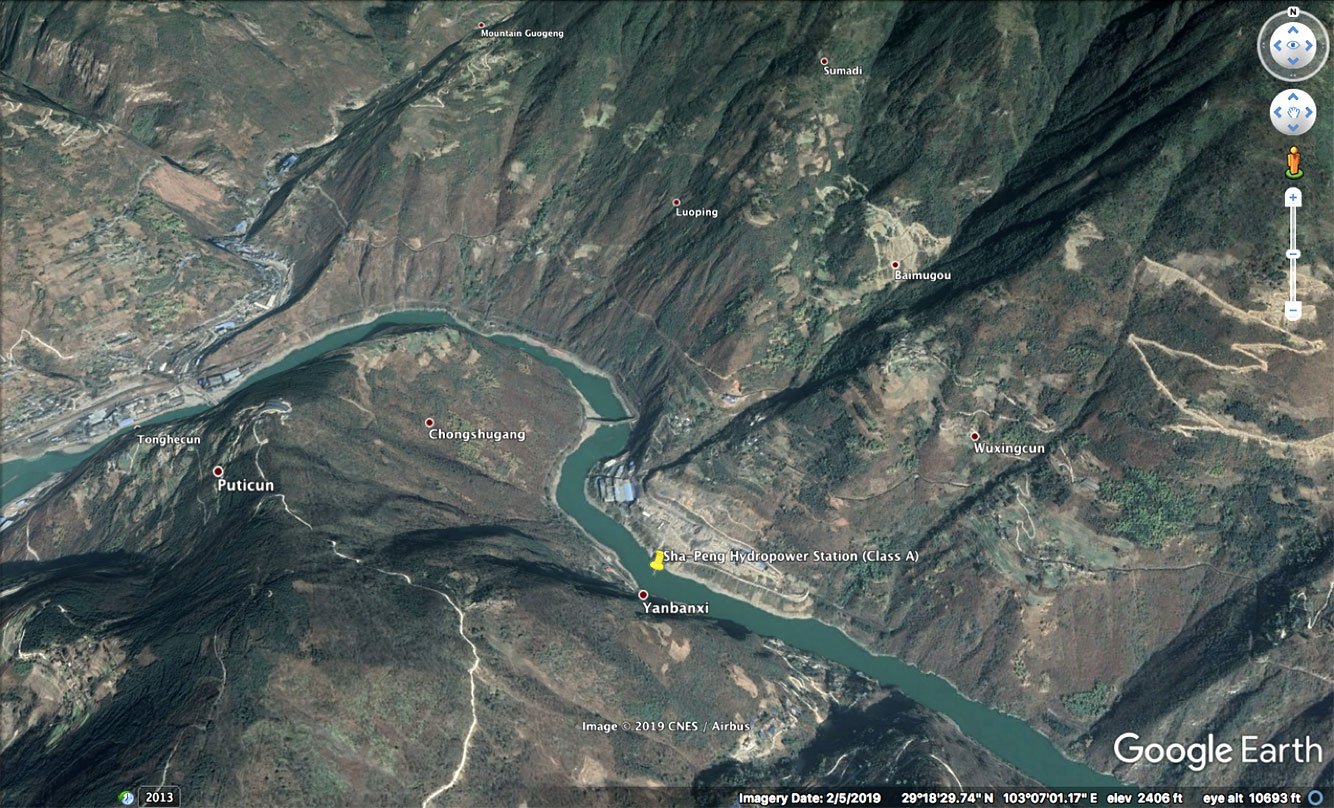
Google Earth image from February 2019.

Google Earth image from February 2019.
Baihetan (白鹤滩) Hydropower Station is located on the Drichu in a mountainous landscape in Ningnan County in Sichuan Province and Qiaojia County in Yunnan Province. A video of this hydropower station on Chinese state television (http://www.cnr.cn/chanjing/gundong/20170804/t20170804_523885103.shtml) shows that construction is well advanced, although the most recent satellite image of the area where the dam is situated available on Google Earth, dated 2017, does not depict the development.
The advanced construction of Baihetan Hydropower Station is also given at this link: https://baike.sogou.com/historylemma?lId=40910&cId=174215701
Baihetan (白鹤滩) Hydropower Station is located on the Drichu in a mountainous landscape in Ningnan County in Sichuan Province and Qiaojia County in Yunnan Province. A video of this hydropower station on Chinese state television (http://www.cnr.cn/chanjing/gundong/20170804/t20170804_523885103.shtml) shows that construction is well advanced, although the most recent satellite image of the area where the dam is situated available on Google Earth, dated 2017, does not depict the development.
The advanced construction of Baihetan Hydropower Station is also given at this link: https://baike.sogou.com/historylemma?lId=40910&cId=174215701

Google Earth image showing Bai He Tan is dated December 29, 2017.

Google Earth image showing Bai He Tan is dated December 29, 2017.
Yinjiang Hydropower Station (银江) is linked to building tourism and urbanization in the area of Panzhihua City, which is where the Drichu and Yarlung Tsangpo rivers meet. Construction, investment and plans for associated resettlement were underway in 2016, according to an investment firm website in 2016, (http://energy.cngold.org/c/2016-02-19/c3911667.html).
Yinjiang Hydropower Station (银江) is linked to building tourism and urbanization in the area of Panzhihua City, which is where the Drichu and Yarlung Tsangpo rivers meet. Construction, investment and plans for associated resettlement were underway in 2016, according to an investment firm website in 2016, (http://energy.cngold.org/c/2016-02-19/c3911667.html).

Google Earth image dated in 2019 as the latest imaginary.

Google Earth image dated in 2019 as the latest imaginary.

Google Earth image dated in 2019 as the latest imaginary.

Google Earth image dated in 2019 as the latest imaginary.


